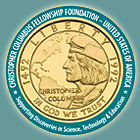
National Gallery for America's Young Inventors
1998 Inductees
Adam E. Cohen, Age 17 - Electrochemical
Paintbrush
The Electrochemical Paintbrush "paints" tiny lines of copper so small that
it can print 50 words end-to-end in a space the width of a human hair. This
is 16 times smaller than present devices used to fabricate microchips.
Jeremy J. Kiser, Age 17 - The Guardian
Angel
The Guardian Angel is a train track warning device. It is comprised of two
simple parts: an inexpensive radio transmitter installed in trains, and a receiver
installed in buses and cars. When a vehicle approaches a train track, the transmitter
signals the bus or car if a moving train is within a distance of one-fourth
mile.
Ariel Krasik-Geiger, Age 12 - Calibrated
Angle and Depth Scissors
While doing a geometry assignment that required cutting specific angles from
a sheet of paper, Ariel got the idea for the Calibrated Angle and Depth Scissors.
These scissors are equipped with a protractor that allows the user to easily
cut precise angles and depths without having to use a pencil.
Karen Mendelson, Age 16 - Inexpensive
Fast Optical Method for Measuring Carbon Monoxide in Whole Blood
Karen read about victims of carbon monoxide poisoning. This poisoning occurs
when fuels are burned in enclosed spaces and can cause flu-like symptoms, often
resulting in death. Karen's battery-powered invention can quickly diagnose
carbon monoxide poisoning by measuring light transmission through blood that
is drawn from a pinprick.
Brian Schreyer, Age 17 - Emergency
Traffic Signal (E.T.S.)
Brian was a part-time emergency medical worker who has used CPR to save lives.
Once, while assisting a victim of an auto accident, Brian noticed that the
policeman on the scene had to spend his time directing traffic rather than
assisting with more urgent matters. This gave Brian the idea for a portable
traffic signal that law officers could use during emergency situations.
Brandon A. Whale, Age 8 - PaceMate
When Brandon was five, his mother received a pacemaker implant. Afterwards,
she frequently had to provide an EKG to the hospital via a telephone modem.
This was done by means of electronic sensors attached to her wrists through
the telephone lines. These sessions were very time consuming as the sensors
were too loose and they did not provide a solid electrical connection. Brandon
furnished the sensors with elastic, which improved the fit. He also prepared
sealed packages containing small electrolyte-soaked sponges to improve electrical
conductivity.
|

